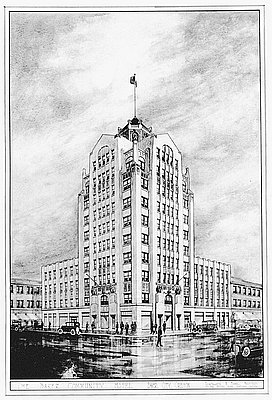One Big City, Many Small Towns
The dominance of Portland as the seat of the state’s wealth, power, and prestige was securely in place by 1910. Still, two-thirds of Oregonians lived outside the city’s immediate reach, on farms and ranches and in the small towns and cities that blanketed the west side of the Cascade Range and were strung along the railroad lines. Major railroad construction continued in Oregon through the 1920s, when two new routes were opened to California, from the Columbia River via Bend and from Eugene via Klamath Falls. They included some spectacular construction projects, including a bridge over the Crooked River gorge and a series of spiraling loops with tunnels, snowsheds, and high steel trestles over Willamette Pass.
The state was relatively late in completing its railroad network, but it was early in beginning a network of paved state highways. The Columbia River Highway, first extending east from Portland and eventually from The Dalles to Astoria, was initially conceived as a pleasure boulevard. When construction began in 1913, automobiles were primarily used as sporting vehicles for the well-to-do and the highway was designed to be beautiful. By the time the final segment was opened in 1924, motor vehicles were no longer just for pleasure, and trucks and buses were cutting into railroad traffic. The Pacific Highway connecting Portland with California was in service by 1915, and it incorporated some of the esthetic qualities that characterized the Columbia River Highway.
The rising importance of roads and highways began to alter the patterns of Oregon’s cities and towns. From the 1880s into the 1920s, most personal travel for business and pleasure centered on the railroad; railroad travelers often stayed at hotels convenient to the railroad station. Beginning in the 1920s, with business and pleasure trips increasingly made by automobile, many small towns built auto-oriented camps and tourist cabins. Larger towns such as Ashland and Astoria promoted the construction of landmark downtown “community hotels” that catered to motorists, often designed with stylish Art Deco flourishes.
© Richard H. Engeman, 2005. Updated by OHP staff, 2014.
Sections

Native Ways and Explorers' Views before 1800

Euro-American Adaptation and Importation

Sawn Lumber and Greek Temples, 1850-1870

Architectural Fashions and Industrial Pragmatism, 1865-1900

Revival Styles and Highway Alignment, 1890-1940

International, Northwest, and Cryptic Styles

Glossary

Built Environment Bibliography
Related Historical Records
Threshing near Klamath Falls
This postcard shows farmers using a steam-powered thresher near Klamath Falls, which was originally called Linkville. In 1909, the Southern Pacific Railroad reached Klamath Falls, helping attract more …

Baker Community Hotel
The Portland office of architects Tourtellotte & Hummel, headquartered in Boise, Idaho, prepared this artist’s rendering of the Baker Community Hotel, which opened in 1929. The hotel was …
